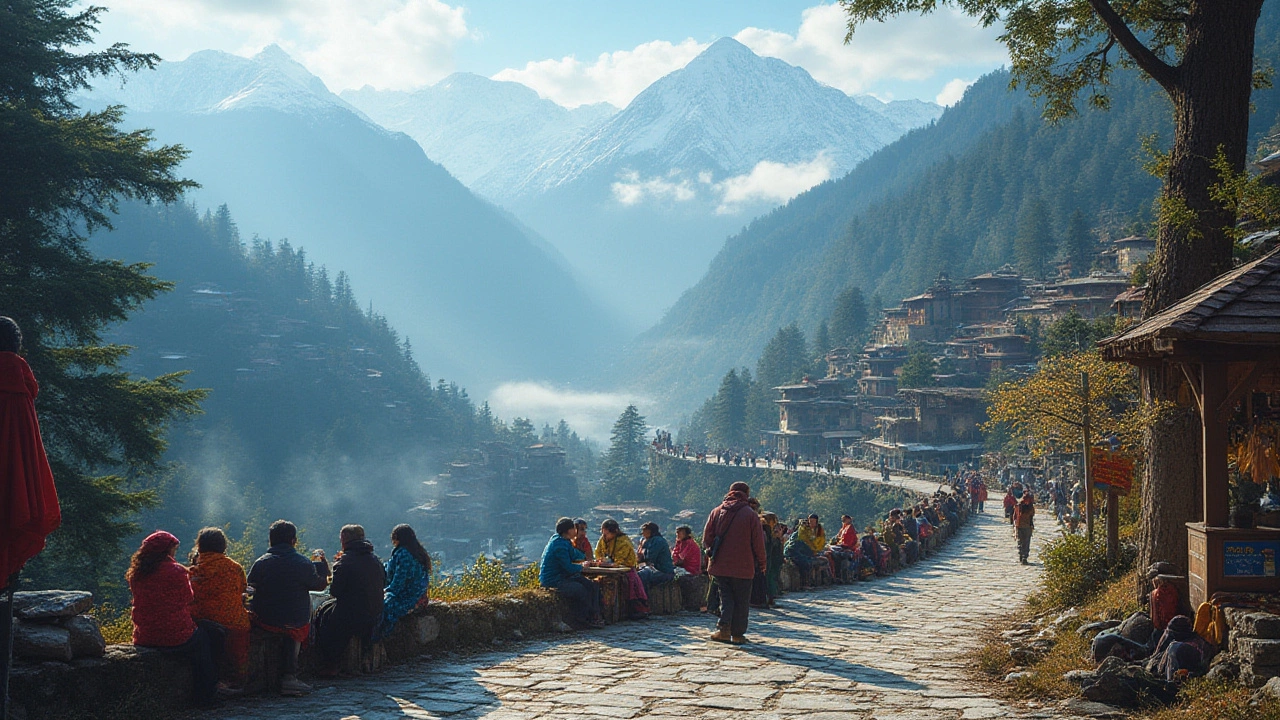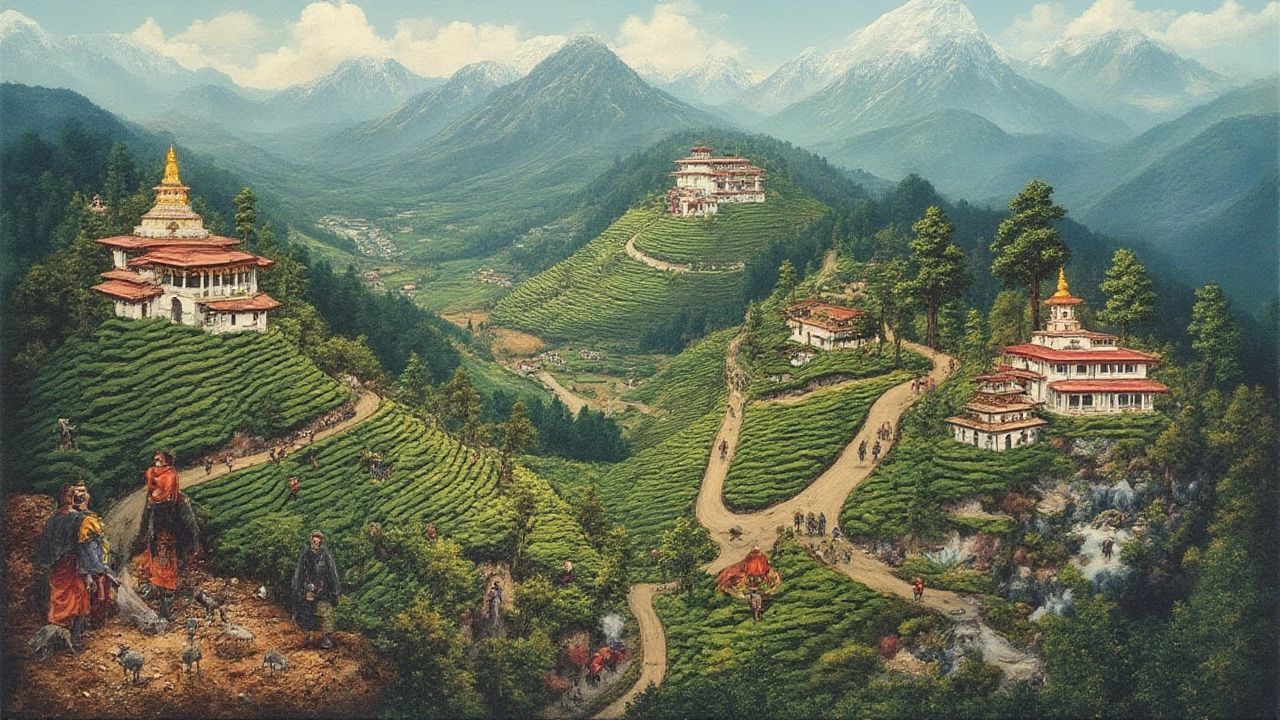Which State in India Has the Most Hill Stations? Ultimate Guide for Travelers
 Jul, 16 2025
Jul, 16 2025
Fog rolling over green ridges, crisp winds just cool enough for sweaters, teapots whistling in wooden cottages—there’s something timeless about India’s hill stations. But here’s a question not every traveler can answer: which state actually has the most hill stations? It’s not just about numbers on a map. Each state’s hill stations carry their own signature vibe, history, and climate. Let’s get real—this isn’t one of those dry geography lessons. If you’re itching to swap city chaos for a mountain escape, knowing the right state can save effort and guarantee the most options. There’s a reason why certain names keep popping up when you ask backpackers, families, and even honeymooners where to head for breezy air and pine forests. Ready to see which state tops the hill station charts—and why?
India’s Hill Station Landscape: Where Nature and Culture Meet
If you ever traced your finger across an Indian map, you'll spot a crazy sprawl of mountains, valleys, and plateaus. But hill stations are not just wherever there’s a hill. Look at the Himalayas in the north—isn’t that every travel brochure’s dream? Then there’s the Western Ghats, slicing through the west and south, each range packed with cool-weather getaways.
But, surprise—India’s hill stations aren’t scattered evenly. Most are clustered in the North, East, and South. Think of places like Himachal Pradesh, Uttarakhand, West Bengal, Tamil Nadu, and Maharashtra. And while all these states have their gems, not all of them boast large numbers of recognized hill stations.
If you’re chasing the *most* hill stations, Himachal Pradesh usually comes up top. This isn’t just random opinion. Himachal is nicknamed “Land of the Gods” and, jokingly, “Land of Many Hill Stations.” Pull up any travel forum, and the list goes long: Shimla, Manali, Dharamshala, Dalhousie, Kasauli, Chail, Kufri, Narkanda, Solan, Kullu, McLeod Ganj—it just keeps going. Some folks count as many as thirty recognized hill stations. Even people from other states call Himachal “India’s backyard Switzerland.”
But let’s not ignore Uttarakhand, right next door. It’s almost neck and neck when it comes to famous names: Nainital, Mussoorie, Almora, Ranikhet, Lansdowne, and Auli, plus the spiritual vibes of places like Haridwar and Rishikesh (though technically at lower elevations). Yet, if you want sheer numbers, most guides and locals still point to Himachal.
The Southern states slice in with their own flavor. Tamil Nadu’s Nilgiris district gives you Ooty (sometimes called the “Queen of Hill Stations”), Coonoor, Kotagiri, Yercaud, and Kodaikanal. The Western Ghats in Maharashtra showcase Mahabaleshwar, Matheran, Panchgani, Lonavala, and a bunch more. Still, they simply don’t have the dizzying count you find in Himachal.
What’s behind this? It’s geography, really. Himachal’s terrain is almost all mountainous, so nearly every major settlement above a certain height has become a scenic escape. British colonial rulers first popularized these spots, setting up “summer capitals” away from Delhi’s heat. Many towns started as sanatoriums or rest stops, eventually morphing into full-blown tourist hotbeds after independence.
And culture? It seeps in everywhere. From ancient temples in the hills of Mandi or Kullu, to Tibetan monasteries in McLeod Ganj, there’s more than just the scenery. Local traditions, arts, and even food get distinct up in the hill stations, blending old and new. You’ll notice—street food and cafés up here taste like a fusion of Indian, Tibetan, and quirky colonial cafe fare.
Curious travelers often ask about the best time to visit, and you can’t pin down one season. Winters bring snow to Manali and Kufri, summers promise rhododendron blossom in Kangra, and every monsoon, the slopes go lush and misty. Each hill station has its own rhythm, so plan based on the experience you want—quiet trekking, cozying up with hot chai after snowfall, or collecting Instagram-perfect views during spring blooms.
Himachal Pradesh’s dominance isn’t just a numbers game. The state government invests heavily in road access and visitor amenities, more than many neighboring states. That means whether you’re landing at a major airport or chugging in by train, you’re never too far from a well-developed hill station. It’s one reason family travelers, weekenders from Delhi, and even trekking junkies keep coming back year after year.

How India’s States Stack Up: Comparing Hill Stations Across the Map
It’s easy to get caught up in the beauty of a single hill station, but if you’re the type who wants to “collect” hill towns like stamps, you’ll need the big picture. So, who else competes in the hill station sweepstakes?
Himachal Pradesh isn’t just leading; it sets the gold standard. Talk to anyone who’s cruised the winding highways through Shimla, Mandi, or Chamba district—you’ll hear stories about completely different cultures and landscapes just a couple of valleys apart. No wonder some frequent visitors give each place a unique pet nickname, like how people call Chail the “hidden retreat” or call Tirthan Valley “the trout hub.” Even tiny, lesser-known spots like Barot or Shoja are getting cult followings among offbeat travelers.
Uttarakhand is the underdog that never feels second-best. Some say its lake-dotted hills (think Nainital) and spiritual hot-spots (Rishikesh and Haridwar) add a mystical twist the others don’t. Adventure buffs come here for bungee-jumping, ziplining, or even skiing in Auli. Still, it doesn’t have quite as many distinct hill station towns when you count up every little settlement, compared with Himachal.
Maharashtra shows that hill stations aren’t just a northern feature. While most have heard of Mahabaleshwar, Matheran, or Panchgani, this state also sneaks in a bunch of tiny townships and offbeat escapes—many close enough for Mumbai weekenders to visit after work without booking a flight. But geography works against the sheer number: these are pockets in the massive Western Ghats, not whole regions filled with hundreds of valleys.
The Southern states—especially Tamil Nadu—bring their unique magic. Ooty’s steam trains, Kodaikanal’s lakes, and Coonoor’s tea plantations have drawn travelers for decades, with a more laid-back, old-school charm. Kerala’s Munnar and Wayanad are gaining popularity, but both states have fewer classic “hill station” towns, as their hilly areas are used more for tea and spice plantations than high-altitude escapes.
If you zoom further east to West Bengal, Darjeeling grabs headlines with its colonial toy train and views of Kanchenjunga. Kalimpong, Kurseong, and Lava add variety, but quantity isn’t as staggering as in the north.
For the trivia fans: some places you wouldn’t expect have tiny hill stations—like Mount Abu in Rajasthan (yes, desert state!) or Saputara in Gujarat. But let's be honest: most travelers don’t come here solely for a chain of hill towns.
So, if quantity is your priority, stick with Himachal Pradesh. For diversity and unique culture, mix it up and hop between Himachal and Uttarakhand. Looking for hill stations with serious coffee and spice vibes? South India (Tamil Nadu or Kerala) could steal your heart.
One thing you’ll notice: each state’s hill stations reflect their own history. In Himachal, the colonial British left behind Victorian architecture and mountain resorts. In Tamil Nadu, you’ll find more bungalows and botanical gardens that date back to the Raj but with a bit more South Indian twist. Darjeeling’s tea plantations come with Tibetan-Buddhist influence, visible in the monasteries and festivals.
Bring your hiking boots if you really want to explore widely—the more you walk, the more you see these differences up close. And don’t be afraid to wander off the “top 5” lists. In every state, you’ll find lesser-known escapes, each with their own version of misty mornings and sunset viewpoints.

Tips for Planning Your Indian Hill Station Adventure
So, now you know where the most hill stations are, how do you make the most of your escape? It’s easy to be overwhelmed by all the options roaming around—especially in Himachal Pradesh, the ultimate winner for the highest number of hill stations.
First off, know what you want out of the trip. If you’re after snowball fights and pine forests, pick higher-altitude stations like Manali, Kufri, or Dalhousie in winter. If you’re more into flower valleys and apple orchards, spring in places like Kullu or Kangra Valley is unbeatable. Love festivals and cultural flavors? Plan around local events like the Shimla Summer Festival or Kullu Dussehra.
Getting around is easier than most expect. In Himachal, buses and local shared taxis run pretty much everywhere, and even the narrow-gauge toy trains between Kalka and Shimla are a tourist adventure in themselves. Still, it pays to book ahead during peak seasons (summer and early winter).
Keep in mind, Himachal towns can get *packed* during tourist rushes. If you’re after peace and quiet, consider smaller places just outside the big-name stations. For example, instead of Shimla, try Mashobra or Naldhera—it’s a ten-minute drive but a whole world calmer.
If you’re the active type, Himachal and Uttarakhand offer every outdoor activity going: trekking, mountain biking, paragliding, river rafting, and fishing. Trekking routes suit everyone from first-timers to experts. Popular treks like Triund (near Dharamshala), Hampta Pass, and Kheerganga attract travelers from all over, but lots of lesser-known routes offer quieter experiences.
Carrying a warm jacket is non-negotiable. Weather swings fast in high altitudes. Don’t get caught in a rainstorm or snowfall in just a t-shirt—locals laugh, but tourists learn the hard way.
Food in the hill stations deserves a shout-out. Try the Himachali dham (a traditional feast), momos filled with spiced cheese or meat, and endless tea at roadside stalls. You can even sample local fruit wines and hand-churned butter, especially if you visit in harvest season.
Health tip: Hydrate more than usual. Higher altitudes dry you out fast. And don’t forget sunscreen—a cloud-covered mountain day still gives killer sunburns.
Pack light, but don’t skimp on a reliable camera or smartphone—the views from sunrise to starlit nights are magic. Even people who claim not to care about Instagram end up snapping way too many photos.
Final pro tip: respect local customs and natural sites. Many hill stations have ancient temples, shrines, or environmentally-sensitive areas. A little politeness goes a long way, both with residents and fellow travelers.
The beauty of Indian hill stations isn’t just in their landscapes, but in the sheer variety packed into each state—especially in Himachal Pradesh. Whether you want endless options, cultural riches, or quiet escapism, picking the right state can turn your trip from good to unforgettable.